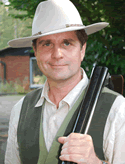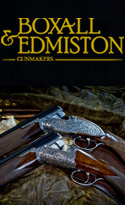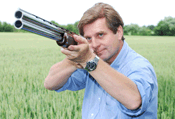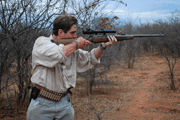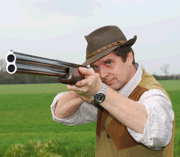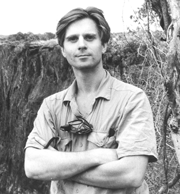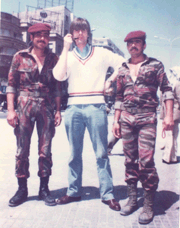Mike's Tip of the Month - Forward Allowance
The subject of forward allowance is one of the most interesting, and certainly one of the most controversial, in shooting. Let us jump straight in at the deep end. If you want to hit a moving target you must shoot where it is going rather than where it was. It never ceases to maze me, even after 40 years of shooting, how much lead some birds need. The other day, for example, I was shooting at a battue clay (much thinner than the standard target) with a friend. It was fully 60 yards away, a true crosser and still very fast. A lot of people had had difficulty with it before us. Having watched them miss behind (typically two or three yards) again and again, I determined not to do the same. Nevertheless, it still took me a couple of shots before I had the courage to get sufficiently in front. Something in the region of 20 feet ahead was required to kill it. I could not believe it needed so much.
Few of us are used to shooting such targets. My disbelief of the lead required reminded me of similar comments from clients when I stretch their limits. Once the bird is more than 30 yards away, whether it is a clay or a rocketing pheasant, many people do not appreciate just how far forward they need to be to kill it. They simply do not understand the extent of the lead required. Birds are missed in front (and we shall discuss this error later) but - as far as average shots are comncerned - most misses are undoubtedly behind. There is a psychological reluctance to shoot into blue sky (most apparent when one tries to teach rifle-trained soldiers to shoot a shotgun). Birds are also missed behind more frequently than they are in front because it is all too easy to stop the gun even when one appreciates the need for lead; poor body rotation, poor visual contact and poor footwork can all be culprits. Sticking to the KISS (Keep it Simple Stupid) philosophy, if everyone increased their lead pictures by 10-20% they would gain more birds than they would lose. On distant targets, I would say the average shot is frequently 50% or more behind.
We all see lead in different ways, some claim not to see it all, many are aware of seeing a gap, some look for a specific distance. With this in mind, you may want consider a few of the many ways one might shoot a moving bird. Click here for more information on different techniques
I am no absolutist, though. Some have suggested (Robert Churchill amongst them) that one need never do more than look at the bird; the subconscious mind will do the rest all circumstance. After much trial in the field I think this advice only holds true to a certain point. I have chosen 30 yards as an arbitrary limit for unconscious shooting (but it might be 25 or 35 or even further depending on the individual). After 30 yards, I believe it is advisable to act a little more deliberately in applying lead whatever specific method one may have used to get in front of the bird. One may simply say: "I am going to give this one a bit extra," or, one may be more deliberate: "this one needs three yards." If one takes either approach, one should, of course, look for the lead at the target. The muzzles are seen, but only in peripheral vision.
People see lead differently, of course. It is often said that one man's inch is another man's yard. Moreover, it is frequently given as a reason for not being specific about leads. I do not buy this entirely. If someone tells you that he sees only a couple of inches of lead it is a sure sign that he is looking at his muzzles, rather than the bird. And, there are, practically speaking, many occasions when it is useful to tell someone to double their lead, "try a yard extra on that" or give them an instruction based on comaprison with the distance between fence posts, the width of a gate - whatever is convenient and may make the point effectively. Provided that you have established a bridge of communication and can read the shot, specific instruction can be a real help to the man who is consistently missing.
We might note, moreover, that most targets have a theoretical or as it might be called "ballistic lead". If I face a very high bird, I will often start by saying: "well, that is about 40 yards away, so I want to be in region of 8 feet ahead". One of the skills of learning to apply lead, is learning to appreciate distance and discovering the specific leads which might work at different distances on standard targets (dig out your Eley diary). I like get clients to shoot the same bird with different leads. Most find they can extend their normal forward allowance and achieve better kills. They also discover that there is usually some considerable margin for error ahead but none behind. Another point one discovers when becoming lead aware, is the huge variation in lead required by different birds. The range of leads that most shots operate within is usually far too restricted. One needs to learn to become brave in applying lead. One needs to be in habit of making quite dramatic variations.
Having gone to considerable length to explain the dangers of missing behind. I will now come clean and admit many misses in the field are in front most notably when an experienced shot is shooting under pressure at close birds. There is a tendency to misjudge distance and to over swing (I have also noted that right-hand, right master eyed shots, often miss slow, close, clays, from the right. The reason can be similar, but, in addition, this bird is notorious for inducing mysterious eye dominance shifts). At what range is the average pheasant shot 25 yards? It may even be less if we are honest. At such ranges minimal lead is required provided the gun keeps moving. The key to success is to sustain this movement without rushing. I might also note that I think it is is inadvisable to use maintained lead on such birds (as the technique can aggravate the tendency to miss in front).
The problems of forward allowance may be summed up thus. Many shots have not developed sufficient understanding of lead nor have they developed sufficient feel for it. The range of leads required by different targets really is extraordinary. One must introduce this flexibility into one's shooting and not attempt to shoot everything the same way. Leading a bird often demands that you are a bit adventurous; you have to risk it sometimes. Lack of confidence will cause the gun to stop. Bringing the weight back will do the same. As an exercise, try shooting driven clay birds by different methods. Try birds at different ranges and elect to kill them in different places. Experiment with subconcious and deliberate lead (try the 30 yard rule). Whatever method you use, always try to shoot smoothly with control and good rhythm. Bore holes in the bird with your eyes and keep the barrels moving and your head on the stock as you follow through.


